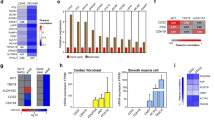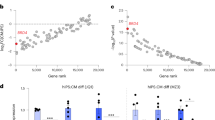Abstract
Regulation of multipotent cardiac progenitor cell (CPC) expansion and subsequent differentiation into cardiomyocytes, smooth muscle or endothelial cells is a fundamental aspect of basic cardiovascular biology and cardiac regenerative medicine. However, the mechanisms governing these decisions remain unclear. Here, we show that Wnt/β-catenin signalling, which promotes expansion of CPCs1,2,3, is negatively regulated by Notch1-mediated control of phosphorylated β-catenin accumulation within CPCs, and that Notch1 activity in CPCs is required for their differentiation. Notch1 positively, and β-catenin negatively, regulated expression of the cardiac transcription factors, Isl1, Myocd and Smyd1. Surprisingly, disruption of Isl1, normally expressed transiently in CPCs before their differentiation4, resulted in expansion of CPCs in vivo and in an embryonic stem (ES) cell system. Furthermore, Isl1 was required for CPC differentiation into cardiomyocyte and smooth muscle cells, but not endothelial cells. These findings reveal a regulatory network controlling CPC expansion and cell fate that involves unanticipated functions of β-catenin, Notch1 and Isl1 that may be leveraged for regenerative approaches involving CPCs.
This is a preview of subscription content, access via your institution
Access options
Subscribe to this journal
Receive 12 print issues and online access
$209.00 per year
only $17.42 per issue
Buy this article
- Purchase on Springer Link
- Instant access to full article PDF
Prices may be subject to local taxes which are calculated during checkout





Similar content being viewed by others
Accession codes
References
Cohen, E. D. et al. Wnt/β-catenin signaling promotes expansion of Isl-1-positive cardiac progenitor cells through regulation of FGF signaling. J. Clin. Invest. 117, 1794–1804 (2007).
Kwon, C. et al. Canonical Wnt signaling is a positive regulator of mammalian cardiac progenitors. Proc. Natl Acad. Sci. USA 104, 10894–10899 (2007).
Qyang, Y. et al. The renewal and differentiation of Isl1+ cardiovascular progenitors are controlled by a Wnt/β-catenin pathway. Cell Stem Cell 1, 165–179 (2007).
Cai, C. L. et al. Isl1 identifies a cardiac progenitor population that proliferates prior to differentiation and contributes a majority of cells to the heart. Dev. Cell 5, 877–889 (2003).
Yang, L. et al. Human cardiovascular progenitor cells develop from a KDR+ embryonic-stem-cell-derived population. Nature 453, 524–528 (2008).
Buckingham, M., Meilhac, S. & Zaffran, S. Building the mammalian heart from two sources of myocardial cells. Nature Rev. Genet. 6, 826–835 (2005).
Wu, S. M. et al. Developmental origin of a bipotential myocardial and smooth muscle cell precursor in the mammalian heart. Cell 127, 1137–1150 (2006).
Moretti, A. et al. Multipotent embryonic isl1+ progenitor cells lead to cardiac, smooth muscle, and endothelial cell diversification. Cell 127, 1151–1165 (2006).
Laugwitz, K. L. et al. Postnatal isl1+ cardioblasts enter fully differentiated cardiomyocyte lineages. Nature 433, 647–653 (2005).
Kattman, S. J., Huber, T. L. & Keller, G. M. Multipotent flk-1+ cardiovascular progenitor cells give rise to the cardiomyocyte, endothelial, and vascular smooth muscle lineages. Dev. Cell 11, 723–732 (2006).
Srivastava, D. Making or breaking the heart: from lineage determination to morphogenesis. Cell 126, 1037–1048 (2006).
Christoforou, N. et al. Mouse ES cell-derived cardiac precursor cells are multipotent and facilitate identification of novel cardiac genes. J. Clin. Invest. 118, 894–903 (2008).
Lyons, I. et al. Myogenic and morphogenetic defects in the heart tubes of murine embryos lacking the homeobox gene Nkx2–5 Genes Dev. 9, 1654–1666 (1995).
Stanley, E. G. et al. Efficient Cre-mediated deletion in cardiac progenitor cells conferred by a 3´UTR-ires-Cre allele of the homeobox gene Nkx2–5 Int. J. Dev. Biol. 46, 431–439 (2002).
Prall, O. W. et al. An Nkx2–5/Bmp2/Smad1 negative feedback loop controls heart progenitor specification and proliferation. Cell 128, 947–959 (2007).
Hayward, P., Kalmar, T. & Arias, A. M. Wnt/Notch signalling and information processing during development. Development 135, 411–424 (2008).
Rones, M. S., McLaughlin, K. A., Raffin, M. & Mercola, M. Serrate and Notch specify cell fates in the heart field by suppressing cardiomyogenesis. Development 127, 3865–3876 (2000).
Nemir, M., Croquelois, A., Pedrazzini, T. & Radtke, F. Induction of cardiogenesis in embryonic stem cells via downregulation of Notch1 signaling. Circ. Res. 98, 1471–1478 (2006).
Radtke, F. et al. Deficient T cell fate specification in mice with an induced inactivation of Notch1. Immunity 10, 547–558 (1999).
Srinivas, S. et al. Cre reporter strains produced by targeted insertion of EYFP and ECFP into the ROSA26 locus. BMC Dev. Biol. 1, 4 (2001).
Hsiao, E. C. et al. Marking embryonic stem cells with a 2A self-cleaving peptide: a NKX2–5 emerald GFP BAC reporter. PLoS ONE 3, e2532 (2008).
Votin, V., Nelson, W. J. & Barth, A. I. Neurite outgrowth involves adenomatous polyposis coli protein and beta-catenin. J. Cell Sci. 118, 5699–5708 (2005).
Gottlieb, P. D. et al. Bop encodes a muscle-restricted protein containing MYND and SET domains and is essential for cardiac differentiation and morphogenesis. Nature Genet. 31, 25–32 (2002).
Li, S., Wang, D. Z., Wang, Z., Richardson, J. A. & Olson, E. N. The serum response factor coactivator myocardin is required for vascular smooth muscle development. Proc. Natl Acad. Sci. USA 100, 9366–9370 (2003).
Tan, X., Rotllant, J., Li, H., De Deyne, P. & Du, S. J. SmyD1, a histone methyltransferase, is required for myofibril organization and muscle contraction in zebrafish embryos. Proc. Natl Acad. Sci. USA 103, 2713–2718 (2006).
Ueyama, T., Kasahara, H., Ishiwata, T., Nie, Q. & Izumo, S. Myocardin expression is regulated by Nkx2.5, and its function is required for cardiomyogenesis. Mol. Cell Biol. 23, 9222–9232 (2003).
Wang, D. et al. Activation of cardiac gene expression by myocardin, a transcriptional cofactor for serum response factor. Cell 105, 851–862 (2001).
Zawel, L. et al. DEC1 is a downstream target of TGF-β with sequence-specific transcriptional repressor activities. Proc. Natl Acad. Sci. USA 99, 2848–2853 (2002).
Shen, M. et al. Basic helix-loop-helix protein DEC1 promotes chondrocyte differentiation at the early and terminal stages. J. Biol. Chem. 277, 50112–50120 (2002).
Honma, S. et al. Dec1 and Dec2 are regulators of the mammalian molecular clock. Nature 419, 841–844 (2002).
Harada, N. et al. Intestinal polyposis in mice with a dominant stable mutation of the β-catenin gene. EMBO J. 18, 5931–5942 (1999).
Kwon, C., Hays, R., Fetting, J. & Orenic, T. V. Opposing inputs by Hedgehog and Brinker define a stripe of hairy expression in the Drosophila leg imaginal disc. Development 131, 2681–2692 (2004).
Kwon, C., Han, Z., Olson, E. N. & Srivastava, D. MicroRNA1 influences cardiac differentiation in Drosophila and regulates Notch signaling. Proc. Natl Acad. Sci. USA 102, 18986–18991 (2005).
Dodou, E., Verzi, M. P., Anderson, J. P., Xu, S. M. & Black, B. L. Mef2c is a direct transcriptional target of ISL1 and GATA factors in the anterior heart field during mouse embryonic development. Development 131, 3931–3942 (2004).
Acknowledgements
We thank R. Kopan (Washington Univeristy, St. Louis, MO) and M. M. Taketo (Kyoto University, Kyoto, Japan) for providing Notch1flox and β-catenin/loxP(ex3)loxP mice, respectively. The authors thank G. Howard and S. Ordway for editorial assistance, R.F. Yeh for statistical analyses, K. Cordes for graphical assistance, B. Taylor for manuscript and figure preparation and Srivastava lab members for helpful discussions. C.K. was supported by a fellowship from the American Heart Association (AHA) and California Institute for Regenerative Medicine (CIRM); D.S. was an Established Investigator of the AHA and was supported by grants from NHLBI/NIH and CIRM. This work was also supported by NIH/NCRR grant (C06 RR018928) to the Gladstone Institutes.
Author information
Authors and Affiliations
Contributions
C.K. designed, performed, supervised in vivo and in vitro work and wrote the manuscript; L.Q. performed flow cytometry and EMSA, and contributed in luciferase assays; P.C. designed and performed Isl1 gain-of-function studies and contributed in ChIP and luciferase assays; V.N. performed β-catenin western and Top/Fop flash assays; J.A. contributed to ChIP assays; D.S. designed and supervised this work and wrote the manuscript.
Corresponding authors
Ethics declarations
Competing interests
P.S. serves on the scientific advisory board of iPierian.
Supplementary information
Supplementary Information
Supplementary Information (PDF 606 kb)
Supplementary Information
Supplementary Table 1 (XLS 62 kb)
Supplementary Information
Supplementary Table 2 (XLS 37 kb)
Rights and permissions
About this article
Cite this article
Kwon, C., Qian, L., Cheng, P. et al. A regulatory pathway involving Notch1/β-catenin/Isl1 determines cardiac progenitor cell fate.. Nat Cell Biol 11, 951–957 (2009). https://doi.org/10.1038/ncb1906
Received:
Accepted:
Published:
Issue Date:
DOI: https://doi.org/10.1038/ncb1906
This article is cited by
-
The second heart field: the first 20 years
Mammalian Genome (2023)
-
Human multilineage pro-epicardium/foregut organoids support the development of an epicardium/myocardium organoid
Nature Communications (2022)
-
Key Roles of RGD-Recognizing Integrins During Cardiac Development, on Cardiac Cells, and After Myocardial Infarction
Journal of Cardiovascular Translational Research (2022)
-
Wnt Signaling in Heart Development and Regeneration
Current Cardiology Reports (2022)
-
Adherens junctions organize size-selective proteolytic hotspots critical for Notch signalling
Nature Cell Biology (2022)



